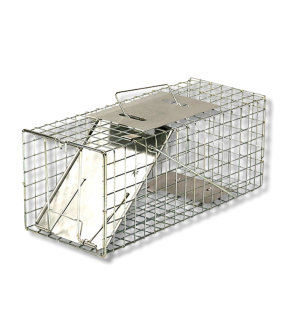Live Animal Traps
Most Effective Products
The Best Live Traps
There are many ways to remove wild animals from your property. A variety of these methods involve poisoning or killing these animals. We at Solutions Pest & Lawn understand that some people may not want to use these methods, and would prefer a more humane way of keeping their area free of wild animals. Using a live trap is a safe and effective way to capture and remove an animal. Live traps can also be used more than once. Be sure to wear gloves when handling the trap to avoid leaving your scent behind.
Recommendation

We recommend the Solutions Live Trap. It is reusable and can be easily cleaned, should you need to use it more than once. The Solutions Live Trap comes in various sizes to trap a wide range of animals. They are ideal to use in public areas or around the home.
User Guide
Step 1: Remove Food Sources

You want the wild animal to respond to the bait placed in your live trap. Because of this, you will need to remove competing food sources. Any trash should be in garbage bags and preferably stored in a bin with a lid. Pet food should be stored inside, as well as any food or water bowls. This will increase your chances of having the wild animal approach your baited trap.
Step 2: Place the Trap

Take note of areas on your property where the wild animal is most active. This is where you will place the trap. Be sure the live trap is on an even surface. In some cases, the animal may attempt to push or knock over the tarp in order to reach the bait inside. To prevent this, you can place a heavy weight such as a brick on top of the live trap.
Common trap placements are:
- Near the foundation of your property
- Entry points in your basement, attic, or garage
- Near wooded areas beside your property
Step 3: Bait and Set the Trap

The bait placed in the live trap will depend on the wild animal you are trying to capture. The bait should be placed near the back of the trap to ensure that the animal will step on the trigger plate.
You will then set your trap by pushing on the door lock and lifting the door plate. Keep the door plate lifted while pulling the trigger arm forward to set it. You will know it is set when the trigger arm's hook catches the door.
Step 4: Monitor the Trap

You will need to check the trap once in the morning and once in the evening. This is when you will refill bait if needed. Checking the trap frequently may dissuade animals from approaching the trap. Do not keep an animal trapped for longer than 24 hours.
Step 5: Relocate the Animal

Any captured non-target animals should be released immediately. Once you have captured an animal, contact your local authorities to make sure you are correctly relocating the animal. Slowly approach the trap and use a gentle voice. Place a towel over the trap to avoid frightening the animal. Once you have relocated, carefully open the trap and release the animal.
Inspection and Maintenance
Besides cleaning in between uses, no maintenance is required for this type of equipment. To clean the Solutions Live Trap, use a mild detergent with warm water. If you choose to clean with bleach, be aware that animals will avoid the trap if it has too strong of a scent.
Parts

The Solutions Live Trap consists of the base, door lock, door plate, trigger plate, and trigger arm. The dimensions are as follows:
- Small Live Trap - 17 in x 7 in x 7 in
- Medium Live Trap - 32 in x 10 in x 12 in
- Large Live Trap - 42 in x 15 in x 15 in
1 - The Body
The body of the trap is a reinforced wire cage made with smooth corners that will prevent animals or trappers from getting hurt. The trap is made of galvanized steel that is easy to clean.
2 - The Door Lock
You will push on the door lock in order to lift the door plate and set the trap. The door lock will also ensure that the wild animal cannot escape the live trap.
3 - The Door Plate
The door plate will need to be lifted to properly set the live trap. Once the trigger plate is activated, the door plate will swing shut and close the live trap.
4 - The Trigger Plate
Once enough weight is placed on it, the trigger plate will activate the door to close and trap the wild animal. Bait should be placed behind the trigger plate so the wild animal can be successfully trapped.
5 - The Trigger Arm
The trigger arm is located on the side of the live trap. Once you have lifted the door plate, you will pull the trigger arm forward in order to set your live trap. You will know the trap is set when the trigger arm's hook catches the door.
Key Takeaways
- Live traps are a humane method of capturing and removing a wild animal from your property. Using a live trap is both safe and effective.
- Be sure to wear gloves when handling the trap. This is to avoid leaving your scent. If wild animals pick up on a human scent, they will avoid the trap.
- Once you have captured a wild animal, contact your local authorities to make sure you are correctly relocating the animal.












































































































































































































































































































































































































































































































































